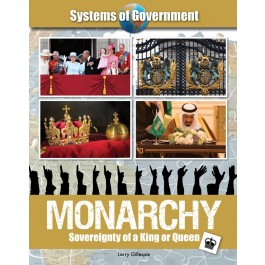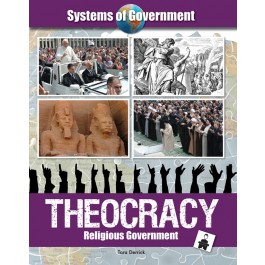SYSTEMS OF GOVERNMENT

8
2019
12+
7th - 12th
7 x 9
by Randy K. Hess
| Hardcover | ISBN 978-1-4222-4015-1 | $25.95 | Add To Cart |
| eBook | ISBN 978-1-4222-7767-6 | $32.95 | Add To Cart |
During the 20th century, communism was one of the world’s dominant forms of government. During the late 1980s, communist regimes held power across much of Asia, Eastern Europe, and parts of Africa. By the early 1990s, however, most of the communist regimes had been replaced. Today only China, Cuba, Laos, North Korea, and Vietnam operate under communist political systems. This book explores the principles that underpin communism, and examines the way communist governments have exercised power in practice. Each title in this series includes color photos throughout, and back matter including: an index and further reading lists for books and internet resources. Key Icons appear throughout the books in this series in an effort to encourage library readers to build knowledge, gain awareness, explore possibilities and expand their viewpoints through our content rich non-fiction books. Key Icons in this series are as follows: Words to Understand are shown at the front of each chapter with
definitions. These words are set in boldfaced type in that chapter, so that readers are able to reference back to the definitions--building their vocabulary and enhancing their reading comprehension. Sidebars are highlighted graphics with content rich material within that allows readers to build knowledge and broaden their perspectives by weaving together additional information to provide realistic and holistic perspectives. Educational Videos are offered in chapters through the use of a QR code, that, when scanned, takes the student to an online video showing a moment in sports' history, a speech, or an instructional video. This gives the readers additional content to supplement the text. Text-Dependent Questions are placed at the end of each chapter. They challenge the reader’s comprehension of the chapter they have just read, while sending the reader back to the text for more careful attention to the evidence presented there. Research Projects are provided at the end of each chapter as well and provide readers with suggestions for projects that encourage deeper research and analysis. And a Series Glossary of Key Terms is included in the back matter containing terminology used throughout the series. Words found here broaden the reader’s knowledge and understanding of terms used in this field.Each title in this series includes color photos throughout, and back matter including: an index and further reading lists for books and internet resources. Key Icons appear throughout the books in this series in an effort to encourage library readers to build knowledge, gain awareness, explore possibilities and expand their viewpoints through our content rich non-fiction books. Key Icons in this series are as follows: Words to Understand are shown at the front of each chapter with definitions. These words are set in boldfaced type in that chapter, so that readers are able to reference back to the definitions--building their vocabulary and enhancing their reading comprehen
by Denice Butler
| Hardcover | ISBN 978-1-4222-4016-8 | $25.95 | Add To Cart |
| eBook | ISBN 978-1-4222-7768-3 | $32.95 | Add To Cart |
Today, the basic ideas underpinning democracy—that government exists for the benefit of the people, and that it must have their consent to be legitimate—may seem obvious. Even dictators pay lip service to these ideas. But the logic of democracy hasn’t always been widely accepted. In fact, throughout most of recorded history, nearly all rulers claimed absolute authority. This book traces the long evolution of government “by the people,” from its roots in the ancient world to the present day. Each title in this series includes color photos throughout, and back matter including: an index and further reading lists for books and internet resources. Key Icons appear throughout the books in this series in an effort to encourage library readers to build knowledge, gain awareness, explore possibilities and expand their viewpoints through our content rich non-fiction books. Key Icons in this series are as follows: Words to Understand are shown at the front of each chapter with
definitions. These words are set in boldfaced type in that chapter, so that readers are able to reference back to the definitions--building their vocabulary and enhancing their reading comprehension. Sidebars are highlighted graphics with content rich material within that allows readers to build knowledge and broaden their perspectives by weaving together additional information to provide realistic and holistic perspectives. Educational Videos are offered in chapters through the use of a QR code, that, when scanned, takes the student to an online video showing a moment in sports' history, a speech, or an instructional video. This gives the readers additional content to supplement the text. Text-Dependent Questions are placed at the end of each chapter. They challenge the reader’s comprehension of the chapter they have just read, while sending the reader back to the text for more careful attention to the evidence presented there. Research Projects are provided at the end of each chapter as well and provide readers with suggestions for projects that encourage deeper research and analysis. And a Series Glossary of Key Terms is included in the back matter containing terminology used throughout the series. Words found here broaden the reader’s knowledge and understanding of terms used in this field.
by Denice Butler
| Hardcover | ISBN 978-1-4222-4017-5 | $25.95 | Add To Cart |
| eBook | ISBN 978-1-4222-7769-0 | $32.95 | Add To Cart |
In a dictatorship, an individual or a small group wield power without legal or constitutional constraints. There are many types of dictators. Some are military officers who overthrow an elected government. Others are democratically elected politicians who, once in office, decide to do away with democracy in order to remain in power. Some dictators use their power to transform society, while others try to prevent social or political change. This book examines the diverse forms of dictatorship. Each title in this series includes color photos throughout, and back matter including: an index and further reading lists for books and internet resources. Key Icons appear throughout the books in this series in an effort to encourage library readers to build knowledge, gain awareness, explore possibilities and expand their viewpoints through our content rich non-fiction books. Key Icons in this series are as follows: Words to Understand are shown at the front of each chapter with definitions.
These words are set in boldfaced type in that chapter, so that readers are able to reference back to the definitions--building their vocabulary and enhancing their reading comprehension. Sidebars are highlighted graphics with content rich material within that allows readers to build knowledge and broaden their perspectives by weaving together additional information to provide realistic and holistic perspectives. Educational Videos are offered in chapters through the use of a QR code, that, when scanned, takes the student to an online video showing a moment in sports' history, a speech, or an instructional video. This gives the readers additional content to supplement the text. Text-Dependent Questions are placed at the end of each chapter. They challenge the reader’s comprehension of the chapter they have just read, while sending the reader back to the text for more careful attention to the evidence presented there. Research Projects are provided at the end of each chapter as well and provide readers with suggestions for projects that encourage deeper research and analysis. And a Series Glossary of Key Terms is included in the back matter containing terminology used throughout the series. Words found here broaden the reader’s knowledge and understanding of terms used in this field.
by Sam Portus
| Hardcover | ISBN 978-1-4222-4019-9 | $25.95 | Add To Cart |
| eBook | ISBN 978-1-4222-7771-3 | $32.95 | Add To Cart |
In the turbulent years after World War I, a new type of governing philosophy known as fascism emerged in a handful of countries—most notably in Italy under Benito Mussolini and in Germany under Adolf Hitler and the Nazi Party. Fascism denied that individuals had any rights the state was bound to respect. It demanded that citizens blindly obey their leader. It glorified violence. It promised to purify a degraded culture and restore the nation to greatness. Fascism led to some of the darkest episodes in human history—including the Holocaust and the Second World War. This book details the rise and fall of a discredited form of government. Each title in this series includes color photos throughout, and back matter including: an index and further reading lists for books and internet resources. Key Icons appear throughout the books in this series in an effort to encourage library readers to build knowledge, gain awareness, explore possibilities and expand their viewpoints through our
content rich non-fiction books. Key Icons in this series are as follows: Words to Understand are shown at the front of each chapter with definitions. These words are set in boldfaced type in that chapter, so that readers are able to reference back to the definitions--building their vocabulary and enhancing their reading comprehension. Sidebars are highlighted graphics with content rich material within that allows readers to build knowledge and broaden their perspectives by weaving together additional information to provide realistic and holistic perspectives. Educational Videos are offered in chapters through the use of a QR code, that, when scanned, takes the student to an online video showing a moment in sports' history, a speech, or an instructional video. This gives the readers additional content to supplement the text. Text-Dependent Questions are placed at the end of each chapter. They challenge the reader’s comprehension of the chapter they have just read, while sending the reader back to the text for more careful attention to the evidence presented there. Research Projects are provided at the end of each chapter as well and provide readers with suggestions for projects that encourage deeper research and analysis. And a Series Glossary of Key Terms is included in the back matter containing terminology used throughout the series. Words found here broaden the reader’s knowledge and understanding of terms used in this field.
by Larry Gillespie
| Hardcover | ISBN 978-1-4222-4020-5 | $25.95 | Add To Cart |
| eBook | ISBN 978-1-4222-7772-0 | $32.95 | Add To Cart |
Monarchy is a form of government in which a hereditary ruler serves as head of state, typically for life. Monarchies have existed since the dawn of human civilization. But while the kings and queens or emperors and empresses of the past wielded broad (and often absolute) power, many of today’s monarchs perform ceremonial functions only. This book examines the various forms that monarchy has taken. Each title in this series includes color photos throughout, and back matter including: an index and further reading lists for books and internet resources. Key Icons appear throughout the books in this series in an effort to encourage library readers to build knowledge, gain awareness, explore possibilities and expand their viewpoints through our content rich non-fiction books. Key Icons in this series are as follows: Words to Understand are shown at the front of each chapter with definitions. These words are set in boldfaced type in that chapter, so that readers are able to reference back
to the definitions--building their vocabulary and enhancing their reading comprehension. Sidebars are highlighted graphics with content rich material within that allows readers to build knowledge and broaden their perspectives by weaving together additional information to provide realistic and holistic perspectives. Educational Videos are offered in chapters through the use of a QR code, that, when scanned, takes the student to an online video showing a moment in sports' history, a speech, or an instructional video. This gives the readers additional content to supplement the text. Text-Dependent Questions are placed at the end of each chapter. They challenge the reader’s comprehension of the chapter they have just read, while sending the reader back to the text for more careful attention to the evidence presented there. Research Projects are provided at the end of each chapter as well and provide readers with suggestions for projects that encourage deeper research and analysis. And a Series Glossary of Key Terms is included in the back matter containing terminology used throughout the series. Words found here broaden the reader’s knowledge and understanding of terms used in this field.
by Larry Gillespie
| Hardcover | ISBN 978-1-4222-4021-2 | $25.95 | Add To Cart |
| eBook | ISBN 978-1-4222-7773-7 | $32.95 | Add To Cart |
In an oligarchy, political power rests with a small privileged group. Oligarchs may exercise power directly or indirectly, but they often act out of selfish or corrupt motives. This book examines the history of oligarchy, which was first described by the ancient Greeks more than 2,300 years ago. The book also asks whether today’s super-rich constitute a new oligarchy that threatens to undermine democracy in the United States and elsewhere. Each title in this series includes color photos throughout, and back matter including: an index and further reading lists for books and internet resources. Key Icons appear throughout the books in this series in an effort to encourage library readers to build knowledge, gain awareness, explore possibilities and expand their viewpoints through our content rich non-fiction books. Key Icons in this series are as follows: Words to Understand are shown at the front of each chapter with definitions. These words are set in boldfaced type in that chapter,
so that readers are able to reference back to the definitions--building their vocabulary and enhancing their reading comprehension. Sidebars are highlighted graphics with content rich material within that allows readers to build knowledge and broaden their perspectives by weaving together additional information to provide realistic and holistic perspectives. Educational Videos are offered in chapters through the use of a QR code, that, when scanned, takes the student to an online video showing a moment in sports' history, a speech, or an instructional video. This gives the readers additional content to supplement the text. Text-Dependent Questions are placed at the end of each chapter. They challenge the reader’s comprehension of the chapter they have just read, while sending the reader back to the text for more careful attention to the evidence presented there. Research Projects are provided at the end of each chapter as well and provide readers with suggestions for projects that encourage deeper research and analysis. And a Series Glossary of Key Terms is included in the back matter containing terminology used throughout the series. Words found here broaden the reader’s knowledge and understanding of terms used in this field.
by Larry Gillespie
| Hardcover | ISBN 978-1-4222-4018-2 | $25.95 | Add To Cart |
| eBook | ISBN 978-1-4222-7770-6 | $32.95 | Add To Cart |
How did large, complex states develop from small clans and nomadic tribes? How have rulers throughout history justified their right to govern? What ideas and events shaped the development of modern forms of government? The Evolution of Government answers these and other important questions, providing an overview of the many different types of governments that human societies have created, as well as advantages and disadvantages to each of these political systems. Each title in this series includes color photos throughout, and back matter including: an index and further reading lists for books and internet resources. Key Icons appear throughout the books in this series in an effort to encourage library readers to build knowledge, gain awareness, explore possibilities and expand their viewpoints through our content rich non-fiction books. Key Icons in this series are as follows: Words to Understand are shown at the front of each chapter with definitions. These words are set in boldfaced
type in that chapter, so that readers are able to reference back to the definitions--building their vocabulary and enhancing their reading comprehension. Sidebars are highlighted graphics with content rich material within that allows readers to build knowledge and broaden their perspectives by weaving together additional information to provide realistic and holistic perspectives. Educational Videos are offered in chapters through the use of a QR code, that, when scanned, takes the student to an online video showing a moment in sports' history, a speech, or an instructional video. This gives the readers additional content to supplement the text. Text-Dependent Questions are placed at the end of each chapter. They challenge the reader’s comprehension of the chapter they have just read, while sending the reader back to the text for more careful attention to the evidence presented there. Research Projects are provided at the end of each chapter as well and provide readers with suggestions for projects that encourage deeper research and analysis. And a Series Glossary of Key Terms is included in the back matter containing terminology used throughout the series. Words found here broaden the reader’s knowledge and understanding of terms used in this field.
by Tara Derrick
| Hardcover | ISBN 978-1-4222-4022-9 | $25.95 | Add To Cart |
| eBook | ISBN 978-1-4222-7774-4 | $32.95 | Add To Cart |
Historically, theocracy has been a fairly rare form of government. Still, theocracies have appeared all over the globe, and they have taken a variety of forms. This book examines theocratic governments, from ancient Egypt to present-day Iran. It explores how different theocracies arose, how their leaders maintained authority, and what it was like for ordinary people living under religious rule. Theocracy will provide students with a wealth of fascinating and thought-provoking information. Each title in this series includes color photos throughout, and back matter including: an index and further reading lists for books and internet resources. Key Icons appear throughout the books in this series in an effort to encourage library readers to build knowledge, gain awareness, explore possibilities and expand their viewpoints through our content rich non-fiction books. Key Icons in this series are as follows: Words to Understand are shown at the front of each chapter with definitions. These
words are set in boldfaced type in that chapter, so that readers are able to reference back to the definitions--building their vocabulary and enhancing their reading comprehension. Sidebars are highlighted graphics with content rich material within that allows readers to build knowledge and broaden their perspectives by weaving together additional information to provide realistic and holistic perspectives. Educational Videos are offered in chapters through the use of a QR code, that, when scanned, takes the student to an online video showing a moment in sports' history, a speech, or an instructional video. This gives the readers additional content to supplement the text. Text-Dependent Questions are placed at the end of each chapter. They challenge the reader’s comprehension of the chapter they have just read, while sending the reader back to the text for more careful attention to the evidence presented there. Research Projects are provided at the end of each chapter as well and provide readers with suggestions for projects that encourage deeper research and analysis. And a Series Glossary of Key Terms is included in the back matter containing terminology used throughout the series. Words found here broaden the reader’s knowledge and understanding of terms used in this field.


























